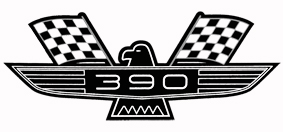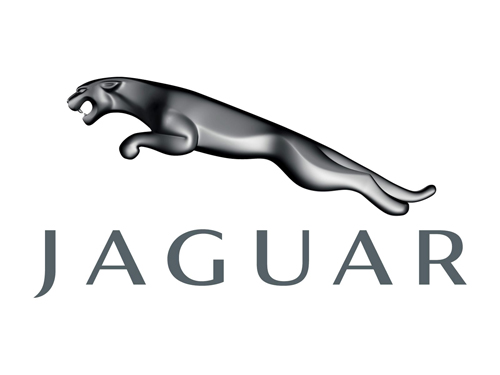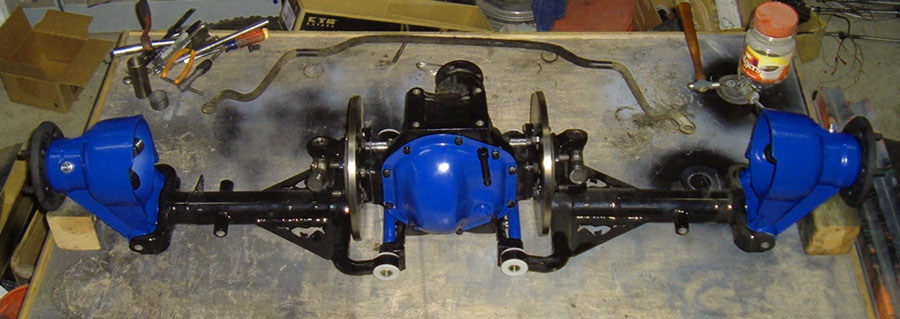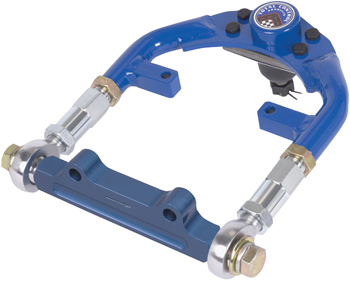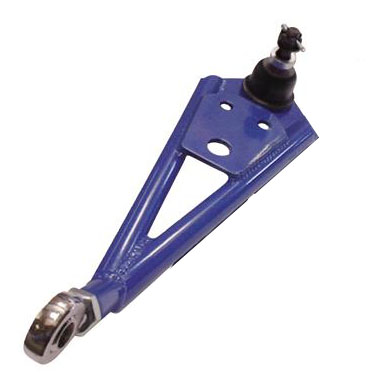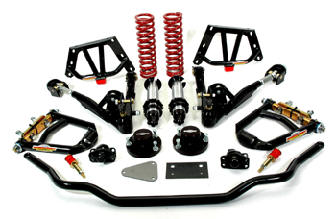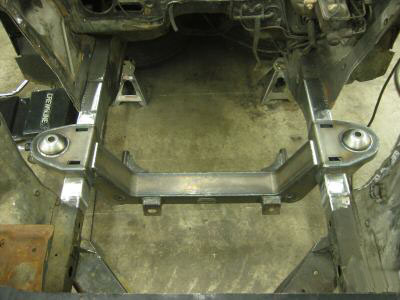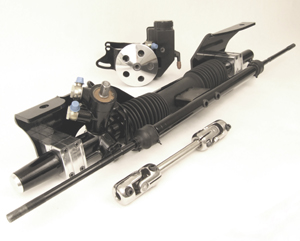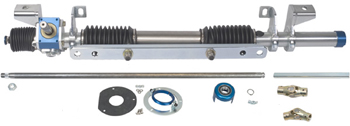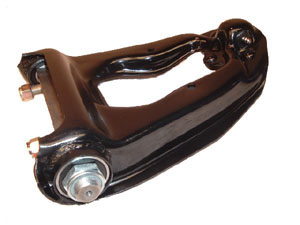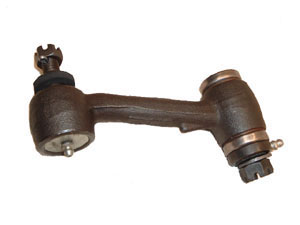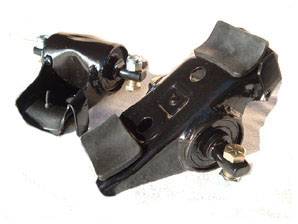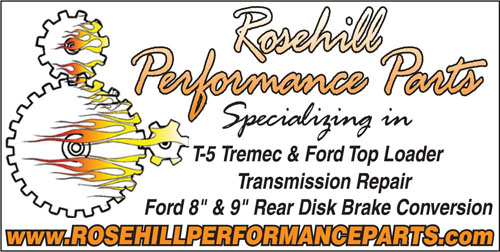
 |
“In order to correctly design a suspension package for your car, you need to first take a hard look at what you want to do with the car so that you can correctly build a suspension ideal for that application or a suspension that is the best compromise for varied applications.”
“In order to correctly design a suspension package for your car, you need to first take a hard look at what you want to do with the car so that you can correctly build a suspension ideal for that application or a suspension that is the best compromise for varied applications.” Other than the golden rule,
there are some
other good concepts/rules to keep in mind when dealing with Mustang
suspension:
1. The parts are designed to move so, if you can free them up to move as designed, then the car will handle better. 2. Automotive suspension does not like geometry changes. 3. Stiffer is not always better in springs. 4. There is no such thing as a good "one size fits all kit" unless you want the street/track profile the kits are all geared to. 5. A suspension that works well for one application/individual is not going to be good for all others. 6. Suspension is a complete system! Parts work together and changing one part without looking at how it works with the other parts may reduce handling rather than improving it. For best results, a suspension must be tuned within itself. 7. When it comes to suspension, there are lots of facts and opinions. Be careful when seeking advice because a lot of people have an opinion but not all of them have the facts. Specific
areas of suspension covered on this page
Ride quality Ride
quality is different
things to different
people. To some it is the ability of a car to hold the road,
for
others it is the comfort level (does the car float down the road, feel
every bump crack or pebble, or is the suspension so stiff that instead
of a classic Mustang you have a tank). For the purpose of
this
article ride quality will henceforth refer to comfort. Good
ride
quality would be a car with suspension that reacts well to changing
road conditions without transferring road vibration and bumps to the
driver and would not feel stiff and clunky like a tank. For
some
applications, ride quality is paramount and, for others, it is not an
issue at all. Keep in mind that in some cases, ride quality
is
traded for increased performance and, depending on your desired
application, a balance will need to be reached.
Street profile For a street car,
I always recommend
putting ride quality ahead of performance. Don’t
get me wrong,
just because a car has good ride quality does not mean it will have
poor handling, but rather, when it comes to certain parts, ride quality
needs to be the priority. One really good way to achieve a good balance
between ride quality and performance is to run softer springs and
performance shocks (more on this in the spring/shock section).
For a street car, never go more than a 1"
front
sway bar and you probably won't want to put a sway bar on the
rear. Free up the suspension with free moving parts like
roller
spring perches and adjustable strut rods to let the suspension do its
job because, in the real world, road conditions are always changing.
Track profile For a track car or
drag car, the
pavement should be smooth so run stiffer springs and bigger sway bars
both front and rear. Make sure your rear end is set up with
traction control options like traction bars. Also for these
cars,
tire scrubbing is not really a concern so replace the performance
alignment with an aggressive alignment (lots and lots of positive
caster and lots of negative camber). As with the street
profile,
free up the suspension with parts like adjustable strut rods and roller
spring perches.
Dual street/track profile Trying to do both
can be hard. In
many cases you will have a car that is a bit of a harsh ride on the
street and not quite stiff enough on the track, but compromises can be
made. Most people that choose to do both lean more to the
track
configuration above and live with the harsher ride on the
street.
Alignment When it comes to alignment there are three main factors: caster, camber, and toe. Caster is determined by the position of the spindle in relation to the plane of the road when looking at it from the side. In other words, caster is the relationship between the spindle and the road when looking at the face of the hub, drum or rotor. If a line bisecting the center of both the upper and lower ball joints as they attach to the spindle sits at a perfect 90 degrees in relation to the road, then the caster is set at zero. Tilting the spindle so that the top of the bisecting line leans towards the front of the car and the bottom of the line leans towards the rear of the car results in negative caster, just as tilting the spindle so that the top of the same line leans towards the back of the car and the bottom of the line leans towards the front of the car results in positive caster. Camber, like caster, also relates to the tilt of the spindle and, more specifically, the tilt of the tire, but instead of being determined from the side, it is looked at along the length of the tire. With camber, if the tire is perfectly vertical, then camber is at zero. Tilting the top of the tire out away from the engine compartment results in positive camber, just as tilting the top of the tire towards the engine compartment results in negative camber. 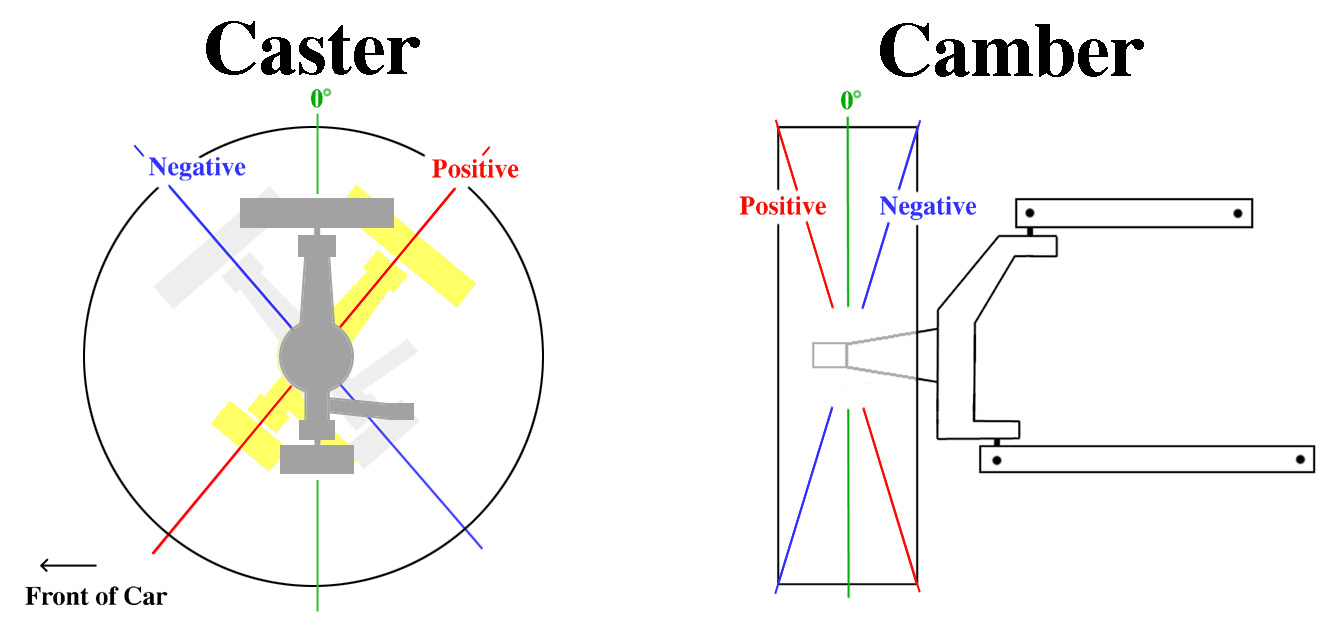 The single biggest factor between a good handling Mustang with a good feel, excellent rubber to road contact, and decent ride quality is the alignment. Regardless of your suspension configuration, DO NOT use Ford's alignment specs!!!!! When you go to have your car aligned, the shop will either punch your info into a computer or look it up in a book and, based on the year of your car, motor size and a few other things, they will get Ford’s alignment tolerances. There are several problems with these numbers. First, the range on them is too vast. If a Mustang is aligned using Ford’s specs and one side has the factory minimum and other side the factory maximum, the car will wander and not hold the road very well at all. So, the first and most important fact to aligning a Mustang correctly is there should be no more than .25 degrees difference between the driver’s side and passenger’s side for the same type of measurement. In other words, caster on the driver’s side needs to be within .25 degrees of caster on the passenger’s side, but has no bearing on either of the camber settings. Example, if the caster on the driver’s side is + 2.5 and the camber is -.25 degrees, then the setting for the passenger’s side caster needs to be between + 2.25 and + 2.75, and the camber needs to be set between 0 and -.5, keeping in mind that .25 is the MAXIMUM difference and the closer to being the same the setting gets, the better. The second problem with Ford’s specs is they were designed for passive driving and 1960’s tires. This is evident in the fact that Ford’s specs allow for positive camber. The third thing you need to realize is that aligning any classic Mustang, but especially a first generation one (‘64.5-‘66), is not as simple as tighten this or loosen a bolt or two. First generation Mustangs use shims to set the alignment. When you change caster, it will affect the camber settings and so forth. Also, depending on the condition of the car and the way things are set up, some settings may not be achievable, so a range of acceptable specs needs to be given to the alignment technician, along with the order of importance so that the correct compromises are made, should the need arise. The following are performance alignment specs for a classic Mustang. I recommend printing out the info specific to your year of car and take it into the alignment shop.
Also, make sure
you trust your alignment
shop. Alignment technicians are trained to work on a variety
of
cars, so most will not know the specifics of a Mustang and they go by
what the book or computer tells them. To make maters worse,
many
of these same technicians believe the owner of the car has no clue what
they really need, so they will tell you that they used your specs but
still use Ford’s specs. Always get a print out of
what the car
was set at when it went in to the shop and what it is was set at when
it came out.
For first
generation Mustangs, there are
parts you can add to make the alignment process easier and anything you
can do to ease the alignment of an early Mustang is a good
thing.
These parts are a Vario-Camber kit and adjustable strut rods.
By
lengthening or shortening the strut rods, you can adjust caster and the
vario kit allows you to modify the mounting location of the LCA, which
changes camber. Even with these adjustments, for best results
the
car should be aligned part way with shims and then use the other two
adjustments to fine tune things. This is not as crucial with
the
camber setting and all of that adjustment could be done with the kit,
however, the bulk of the caster should be done with shims to get it
into the ball park and then fine tuned with the strut rods so that said
rods are nearly the same length. For best results increasing
caster should be done as much as possible by moving the upper ball
joint back rather than pulling the bottom ball joint forward.
I
would even go so far as to say that on a ’67 and up UCA, the
use of a
washer or two between the front stud and the shock tower is a good way
to increase initial caster.
Companies such as TCP and Ron Morris have designed tubular UCAs and LCAs that, through the use of heim joints, LH thread/RH thread adjuster sleeves are able to lengthen or shorten the arm for the purpose of setting the alignment. Buy adjusting the length of the LCA, you can adjust camber and, by shortening and lengthening the front and rear leg of the UCA, you can adjust both camber and caster. These types of setups have the advantage of being able to dial the alignment setting in exactly so that all settings are spot on. They are also much simpler to use and allow you to maintain identical strut rod length between driver’s and passenger’s sides. The down side to these types of adjustments is that, by changing the length of arms, you are changing the arc of the ball joints, which in turn changes the arc of the spindle. This can affect steering geometry and may result in measurable bump-steer. Don’t get me wrong, I am in no way saying these are not good options, the positive effects of the improved alignment settings may far outweigh any negative effects from varying the length of the arms. Also, the length adjustments needed may be minimal and the smaller the changes, the less effect on steering geometry. These types of arms usually come with upgrade kits, such as a coil over setups, so other improvements afforded by these kits will also work toward eliminating any ill effects caused by varying control arm lengths. I am not suggesting you use or stay away from these types of UCAs and LCAs, basically I am pointing out the pros and cons so you can make an informed decision.
Springs/Shocks 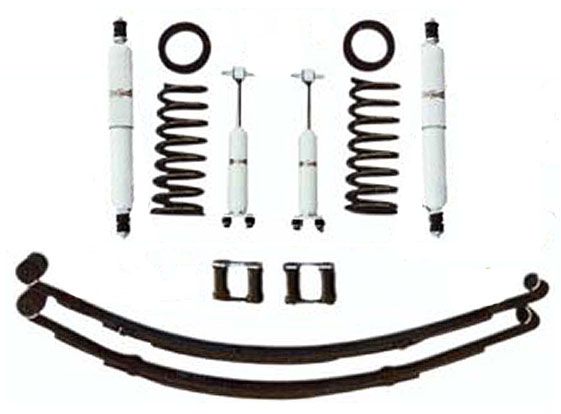 There
is a concept
in the automotive
world at large that the stiffer the springs are, the better a car will
handle. But that concept while being accurate, does not make
stiffer springs the best choice for all applications. The reason
stiffer springs improve handling is that
they
limit suspension movement. As the suspension moves, some of
the
alignment specs, such as camber, will vary through the vertical range
of motion, also know as camber curve. By limiting suspension
travel, you keep the alignment specs closest to the setting set during
the initial alignment. Also, stiffer springs will keep the body of the
car more parallel to the road during hard cornering, which will
maintain more uniform tire to pavement contact between the
driver’s and
passenger’s side and reduce body roll. This results
in better
control and allows for higher speeds through tighter turns.
So,
yes, stiffer springs will improve handling, BUT the problem with
stiffer springs is they come at a direct expense to ride quality and
don’t allow the suspension to properly react in less than
ideal road
conditions which is why extremely stiff springs are not a good option
for a street car. Also when selecting springs and shocks keep in
mind that you need to maintain a balance, in other words stiffer
springs really should have stiffer shocks, just as softer springs
should have softer shocks. There
is a concept
in the automotive
world at large that the stiffer the springs are, the better a car will
handle. But that concept while being accurate, does not make
stiffer springs the best choice for all applications. The reason
stiffer springs improve handling is that
they
limit suspension movement. As the suspension moves, some of
the
alignment specs, such as camber, will vary through the vertical range
of motion, also know as camber curve. By limiting suspension
travel, you keep the alignment specs closest to the setting set during
the initial alignment. Also, stiffer springs will keep the body of the
car more parallel to the road during hard cornering, which will
maintain more uniform tire to pavement contact between the
driver’s and
passenger’s side and reduce body roll. This results
in better
control and allows for higher speeds through tighter turns.
So,
yes, stiffer springs will improve handling, BUT the problem with
stiffer springs is they come at a direct expense to ride quality and
don’t allow the suspension to properly react in less than
ideal road
conditions which is why extremely stiff springs are not a good option
for a street car. Also when selecting springs and shocks keep in
mind that you need to maintain a balance, in other words stiffer
springs really should have stiffer shocks, just as softer springs
should have softer shocks.The idea of stiffer springs being better was born on the track where decreased suspension movement for the reasons mentioned above is better. Also, the surface of the track is smooth so the suspension only needs to compress slightly during cornering and the track environment ride quality is not even something considered. By going with a softer spring, the suspension can move as it was designed to when the wheels encounter imperfections in the road. The problem with really soft springs is that they can allow too much suspension travel, which can result in a spongy ride quality and extreme tilting of the car during hard cornering. For street cars, there is an option that can allow the better ride quality afforded by softer springs and the some of the better handling afforded by stiffer springs. By running a slightly stiffer than stock spring with a performance shock such as a KBY gas adjust (which is slightly stiffer than stock and becomes even stiffer as road conditions require) you allow proper suspension movement, maintaining good tire to road contact, but said movement is more controlled by the shock. The result is a good handling car that does not feel like a tank. Rear springs and shocks are subject to many of the same things as the front ones. Stiffer springs will make for a harsher ride but the same shock/spring combination as mentioned above will give a much better overall ride especially for street cars. Roller Spring Perches:  A spring
perch
bolts to the upper
control arm and serves as a bottom resting point for the coil
springs. The design of the spring perch, through its ability
to
rotate back and forth as the UCA travels up and down, allows the coil
spring to move with more consistent vertical travel through compression
and decompression. The original spring perches found on the
early
Falcons had brass bushings. This allowed for a
smooth
rotation but had the downside of needing regular greasing and
considerable friction between the surface of the bushing and the
journal it rested in. Sometime before the Mustang hit the
market
in 1964, FoMoCo decided to replace the brass bushings with
rubber
ones, which was done primarily to cut costs. Although cheaper
to
produce, the rubber bushing spring perches lacked the smooth,
easy turning radius afforded by the brass bushing.
If you
have ever tried to turn the center shaft in a rubber bushing spring
perch, you know that it takes quite a bit of force to get any
movement. One might argue that a coil
spring provides
all the pressure needed to turn the perch and that a smooth turning
radius is not necessary, but the problem is that the force applied,
from suspension travel, to move the perch prior to the rubber bushing
flexing is absorbed by flexing of the spring and shock. This
flexing of the spring and shock results in a less than consistent,
less-vertical travel during compression and decompression, and thus
puts a lot of stress on the shock, making it wear out sooner.
One
option in correcting this issue is to replace the rubber bushing with
aftermarket brass bushings, returning the perch to the initial Ford
design. This works well, but without regular greasing, brass
bushings tend to squeak. Another option is to create the roller
spring perch. By replacing the rubber bushings with
roller
bearings, a smooth turning radius can be achieved and, thus, smoother
suspension and drivability without the added friction and squeaking of
a brass bushing. A Mustang handles best with its suspension in the
position it was in when it was aligned. Roller spring perches speed up
suspension response time and reduce suspension flex. If you look at a
stock set of spring perches they do not pivot easily this cause undo
flex in other suspension parts and is much slower in response time.
Suspension is designed to move so if you allow it to smoothly do its
job as quickly as possible you will have much better ride and handling
quality. The proof is in the pudding. I have sold hundreds of perches
and Opentracker has sold thousands and all the reviews are the same the
perches make a huge difference!!! They are wonderful for a all
performance car and they are wonderful for a stock car I have
personally put them on both and seen a vast improvement in handling. A spring
perch
bolts to the upper
control arm and serves as a bottom resting point for the coil
springs. The design of the spring perch, through its ability
to
rotate back and forth as the UCA travels up and down, allows the coil
spring to move with more consistent vertical travel through compression
and decompression. The original spring perches found on the
early
Falcons had brass bushings. This allowed for a
smooth
rotation but had the downside of needing regular greasing and
considerable friction between the surface of the bushing and the
journal it rested in. Sometime before the Mustang hit the
market
in 1964, FoMoCo decided to replace the brass bushings with
rubber
ones, which was done primarily to cut costs. Although cheaper
to
produce, the rubber bushing spring perches lacked the smooth,
easy turning radius afforded by the brass bushing.
If you
have ever tried to turn the center shaft in a rubber bushing spring
perch, you know that it takes quite a bit of force to get any
movement. One might argue that a coil
spring provides
all the pressure needed to turn the perch and that a smooth turning
radius is not necessary, but the problem is that the force applied,
from suspension travel, to move the perch prior to the rubber bushing
flexing is absorbed by flexing of the spring and shock. This
flexing of the spring and shock results in a less than consistent,
less-vertical travel during compression and decompression, and thus
puts a lot of stress on the shock, making it wear out sooner.
One
option in correcting this issue is to replace the rubber bushing with
aftermarket brass bushings, returning the perch to the initial Ford
design. This works well, but without regular greasing, brass
bushings tend to squeak. Another option is to create the roller
spring perch. By replacing the rubber bushings with
roller
bearings, a smooth turning radius can be achieved and, thus, smoother
suspension and drivability without the added friction and squeaking of
a brass bushing. A Mustang handles best with its suspension in the
position it was in when it was aligned. Roller spring perches speed up
suspension response time and reduce suspension flex. If you look at a
stock set of spring perches they do not pivot easily this cause undo
flex in other suspension parts and is much slower in response time.
Suspension is designed to move so if you allow it to smoothly do its
job as quickly as possible you will have much better ride and handling
quality. The proof is in the pudding. I have sold hundreds of perches
and Opentracker has sold thousands and all the reviews are the same the
perches make a huge difference!!! They are wonderful for a all
performance car and they are wonderful for a stock car I have
personally put them on both and seen a vast improvement in handling.Adjustable Strut rods  On
a Ford Mustang,
the factory strut rod
is there to stabilize the lower control arm in a fixed position
that prevents its movement forward and aft, but still allows
it
to travel vertically with suspension compression and decompression. The
stock system is designed so that, during regular driving, the rubber
bushing gives, allowing vertical travel as the lower control arm moves
up and down. The give in the bushings, unfortunately, has a
negative side effect of unwanted movement, they compress and stretch
during braking and acceleration. The result of the compression and
stretching of the rubber bushings is an increase and decrease in the
length of the strut rod. As the strut rod increases and decreases in
length, the lower control arm is not held fixed and can move forward
and aft a small amount, which puts the alignment in a constant state of
change during driving. One option to remove the compression and
stretching of the stock rubber bushings is to replace them with
polyurethane bushings. The polyurethane reduces the movement of the
strut rod, which alleviates the issue of compression and stretching,
however, it has the unfortunate consequence in that it increases the
effort required for normal strut rod movement during
suspension
travel and puts far more strain on the strut rod than it was ever
designed to handle. I have seen many times where people have
bent
or broken their original stock strut rods by replacing the rubber
bushings with polyurethane. For more information on the benefits
of adjustable strut rods as well as information on building a set,
check out my web
page on adjustable strut rods. On
a Ford Mustang,
the factory strut rod
is there to stabilize the lower control arm in a fixed position
that prevents its movement forward and aft, but still allows
it
to travel vertically with suspension compression and decompression. The
stock system is designed so that, during regular driving, the rubber
bushing gives, allowing vertical travel as the lower control arm moves
up and down. The give in the bushings, unfortunately, has a
negative side effect of unwanted movement, they compress and stretch
during braking and acceleration. The result of the compression and
stretching of the rubber bushings is an increase and decrease in the
length of the strut rod. As the strut rod increases and decreases in
length, the lower control arm is not held fixed and can move forward
and aft a small amount, which puts the alignment in a constant state of
change during driving. One option to remove the compression and
stretching of the stock rubber bushings is to replace them with
polyurethane bushings. The polyurethane reduces the movement of the
strut rod, which alleviates the issue of compression and stretching,
however, it has the unfortunate consequence in that it increases the
effort required for normal strut rod movement during
suspension
travel and puts far more strain on the strut rod than it was ever
designed to handle. I have seen many times where people have
bent
or broken their original stock strut rods by replacing the rubber
bushings with polyurethane. For more information on the benefits
of adjustable strut rods as well as information on building a set,
check out my web
page on adjustable strut rods.Front Sway bar 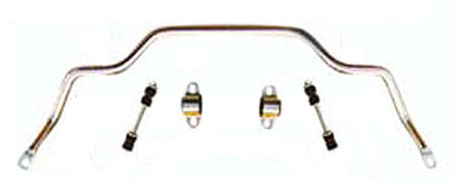 The front
suspension on a Mustang is
independent, meaning that when the wheel on one side of the car hits a
bump or change in the road, that side of the suspension can react to
the road independently of the other side. This is far
superior to
a solid front suspension where a change in one side affects both
sides. The down side to IFS is that during extreme
situations,
especially during hard cornering, the inside wheel’s
suspension will
compress and tilt the car. This causes body roll and shifts a
greater part of the weight to the compressed side, reducing tire to
road pressure on the less compressed side. In a perfect
world,
you want the underside of the car to be as close to parallel to the
road as possible. To maintain the independence but still
reduce
major differences in suspension travel from one side to the other, we
have sway bars. With a sway bar, as the suspension moves on
one
side, the sway bar applies pressure to the other side so that it is
held in relatively the same position, however, the sway bar also flexes
allowing the two sides to have some independence. The thicker
the
sway bar, the less flex. The stock bar on an early Mustang is
quite thin, 5/8”, and flexes easily. A thicker sway
bar will add
more stability, however 1” is, in my opinion, the maximum for
a street
driven car. They make 1.125” and 1.25”
bars but those are better
suited for track cars. The front
suspension on a Mustang is
independent, meaning that when the wheel on one side of the car hits a
bump or change in the road, that side of the suspension can react to
the road independently of the other side. This is far
superior to
a solid front suspension where a change in one side affects both
sides. The down side to IFS is that during extreme
situations,
especially during hard cornering, the inside wheel’s
suspension will
compress and tilt the car. This causes body roll and shifts a
greater part of the weight to the compressed side, reducing tire to
road pressure on the less compressed side. In a perfect
world,
you want the underside of the car to be as close to parallel to the
road as possible. To maintain the independence but still
reduce
major differences in suspension travel from one side to the other, we
have sway bars. With a sway bar, as the suspension moves on
one
side, the sway bar applies pressure to the other side so that it is
held in relatively the same position, however, the sway bar also flexes
allowing the two sides to have some independence. The thicker
the
sway bar, the less flex. The stock bar on an early Mustang is
quite thin, 5/8”, and flexes easily. A thicker sway
bar will add
more stability, however 1” is, in my opinion, the maximum for
a street
driven car. They make 1.125” and 1.25”
bars but those are better
suited for track cars.Rear sway bar 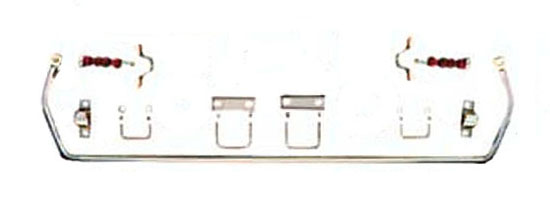 Rear sway
bars on
a Mustang really
change the way the car feels and the way you drive it. For
best
results, the first rule of sway bars is to make the rear one smaller
than the front one. For instance, a 1” in the front
will work
best with a 5/8” to 3⁄4” in the
rear. I can’t emphasize
enough that a rear sway bar really changes the way the car handles,
especially if you do not know how to drive with one. If you
do
not accelerate through corners and step up the aggressiveness of your
driving, the rear sway bar will make the handling feel loose and
uncontrollable. The thicker the bar is, the more noticeable
this
issue will become. The thing that people need to realize is that unlike
a front sway bar, you need to decide if you will be running a rear sway
bar when you select your springs. The stiffer your springs
are,
the more noticeable the effects of the rear sway bar and the more
aggressively you will need to drive. By softening the
springs,
you can get a little better handling with the sway bar without as much
need for aggressive driving. The other thing to consider is
that,
unless changed to IRS, the rear suspension on a Mustang is a solid or
“live axle” and the rear end itself acts much like
a rear sway bar so
this is why adding more stiffness and tying the two sides together
further is not always better. Rear sway
bars on
a Mustang really
change the way the car feels and the way you drive it. For
best
results, the first rule of sway bars is to make the rear one smaller
than the front one. For instance, a 1” in the front
will work
best with a 5/8” to 3⁄4” in the
rear. I can’t emphasize
enough that a rear sway bar really changes the way the car handles,
especially if you do not know how to drive with one. If you
do
not accelerate through corners and step up the aggressiveness of your
driving, the rear sway bar will make the handling feel loose and
uncontrollable. The thicker the bar is, the more noticeable
this
issue will become. The thing that people need to realize is that unlike
a front sway bar, you need to decide if you will be running a rear sway
bar when you select your springs. The stiffer your springs
are,
the more noticeable the effects of the rear sway bar and the more
aggressively you will need to drive. By softening the
springs,
you can get a little better handling with the sway bar without as much
need for aggressive driving. The other thing to consider is
that,
unless changed to IRS, the rear suspension on a Mustang is a solid or
“live axle” and the rear end itself acts much like
a rear sway bar so
this is why adding more stiffness and tying the two sides together
further is not always better.Bump-Steer When it comes to poor handling, Bump-Steer is the "chicken" of the automotive world. In the same way that everyone says "that tastes like chicken", automotive enthusiasts say of a poor handling car, "this car suffers from Bump-Steer." I find it fascinating that simply by taking a test drive, many backyard mechanics, car enthusiasts, and even some automotive professionals can diagnose Bump-Steer as the problem with 100% confidence, especially when they have a limited understanding of what Bump-Steer really is and what causes it. It is much like a young doctor diagnosing a serious and complicated illness in a patient simply by asking them a few questions instead of doing any real tests. Please don’t misunderstand, I am in no way saying that if a car is handling poorly that Bump-Steer is not a possible cause. What I am saying is that Bump-Steer may in deed be the issue, however, it is just as likely that the problem has another cause or a combination of causes. Just as a doctor must know the actual source of the problem to successfully treat his/her patient, we, as car enthusiasts, must accurately diagnose the true issue in our suspension and handling problems to effectively correct them. Also, we must remember that, similar to the medical profession, sometimes more relief is found in dealing with the symptom or "effect" of the problem rather than the real issue. Measurable Bump-Steer is a situation where the suspension components travel to a point were the distance moved is not equally compensated for by the movement of the steering components and, thus, one or both wheels are pulled into an unintended turning position Dealing with Bump steer and or its effect can be done in many ways and is more involved than the basics addressed in this article. For an in-depth understanding on Bump steer and how to deal with it, check out my web page on the subject. UCA drop: What Does The UCA Drop Do?  Three
factors make
lowering the UCA an
improvement in handling. First, this modification to the suspension
lowers the center of gravity on the front of the car; second, body roll
is reduced by 7% to 9%; and third, the camber curve is
improved. Three
factors make
lowering the UCA an
improvement in handling. First, this modification to the suspension
lowers the center of gravity on the front of the car; second, body roll
is reduced by 7% to 9%; and third, the camber curve is
improved. The center of gravity is a geometric property that relates to any shape, but to keep things simple and related to the topic of automobiles, it is basically the internal balancing point from all directions of a car. When you do the UCA drop, you moderately lower the overall height of the front of the car, which in turn lowers the center of gravity. Easier understanding the application of the center of gravity and how it plays a role in vehicle stability can be illustrated by looking at the stability changes in a canoe based on passenger position. If you sit down on the floor of a canoe (low center of gravity) then the boat is extremely stable and nearly impossible to overturn. If you rise up and sit on the seats, the canoe becomes noticeably less stable, but still functional. Finally, if you stand up in a canoe (high center of gravity), the boat becomes completely unstable and will most likely overturn. In the same way the lower the center of gravity is on a vehicle, the more stable it will be. Body roll is a major issue in classic Mustangs. The structure of the Ford Mustang is what is referred to as a unibody design. This means that rather than a stiff full-length frame, the body is built in such a way that it is self-supporting. This design is lighter and was more cost effective for Ford, however, during cornering, especially as you first enter and begin to exit a corner, the Mustang body flexes and results in reduced handling accuracy. When you lower the UCA, you reduce the leverage that the UCA has on the inner fender/shock tower, which in turn reduces the force applied to the body during cornering and thus reduces body roll. The biggest improvements afforded by the UCA drop come from an improved camber curve. Camber is the leaning in or out of the tires. The more negative camber you have the more rubber to road contact you have. If the top of the wheels leans in toward the engine compartment, the wheel has negative camber, whereas if the top of the wheels leans out away from the engine, the wheel has positive camber. In the same way, during cornering or when encountering inconsistencies in the road, if, due to suspension travel, the top of the wheels leans in toward the engine compartment, the wheel has a negative camber curve, or if the top of the wheels leans out away from the engine, due to suspension travel, then the wheel has a positive camber curve. The stock camber curve of the Mustang is positive so, as you corner or if you hit a bump, the top of the wheels leans out, reducing camber, and thus, reducing rubber to road contact which results in inferior handling. By relocating the UCA, the Mustang camber curve is changed from positive to negative, which significantly improves handling. Also, another added benefit of the UCA drop is that the arc of the camber curve is flattened, which results in a much smaller change in camber during full range of suspension motion. So, the camber of the wheels stays closer to the specification it was aligned to during a full range of suspension motion. For more details on the UCA drop check out my UCA drop page. Negative wedge kit 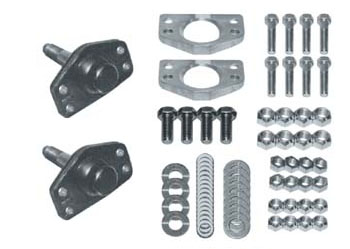 The
negative wedge
kit is a set of
angled shims that allows you to relocate the ball joint on the UCA so
that when doing UCA drops of MORE than 1” the ball joint does
not
bottom out on it self, but the negative wedge kit is not required on
drops of 1” or less. The 1” UCA drop
causes the upper ball joint
to extent to a position near its max tolerance, however, as long as the
suspension bumpers are intact it does not overextend the ball
joint. By increasing ball joint range, a negative wedge kit
allows you to lower the UCA up to a full 1 & 3/4”
from the stock
location, which is the point that creates the most ideal camber
curve. IF YOU LOWER THE UCA MORE THAN 1” YOU MUST
USE A NEGATIVE
WEDGE KIT!!! If you do not, the UCA ball joint will be
extended
past its designed range of motion and separate, which will cause
suspension failure and possibly an accident. Something to
consider before investing in a negative wedge kit is that the benefit
of UCA drops of more than 1” are minimally more effective
than the
standard 1” drop. What I mean to say is that the
difference
between a 1” drop and a drop of 1 & 3/4” is
negligible on a street
driven car. Many people who have purchased the negative wedge
kit
and lowered the UCA more than 1”point out that the difference
between
the 1" and 1 & 3/4" drop is too difficult to see on the street
and
not worth the money, in their opinion. IMHO, the only time
the 1
& 3⁄4” drop is worth the time, effort and or
cost, is when the
car has been built for the circle track and every possible improvement
can mean the difference between a win and a loss.
Also the
negative wedge kit does nothing for suspension and handling by it
self. I have read posts on forums where individuals left
their
UCA in the stock position and installed a negative wedge kit because
they had the misguided idea that it would improve handling.
Relocating the ball joint does NOTHING for handling its only function
is to make UCA drops of more than 1” possible with out
causing ball
joint failure. The
negative wedge
kit is a set of
angled shims that allows you to relocate the ball joint on the UCA so
that when doing UCA drops of MORE than 1” the ball joint does
not
bottom out on it self, but the negative wedge kit is not required on
drops of 1” or less. The 1” UCA drop
causes the upper ball joint
to extent to a position near its max tolerance, however, as long as the
suspension bumpers are intact it does not overextend the ball
joint. By increasing ball joint range, a negative wedge kit
allows you to lower the UCA up to a full 1 & 3/4”
from the stock
location, which is the point that creates the most ideal camber
curve. IF YOU LOWER THE UCA MORE THAN 1” YOU MUST
USE A NEGATIVE
WEDGE KIT!!! If you do not, the UCA ball joint will be
extended
past its designed range of motion and separate, which will cause
suspension failure and possibly an accident. Something to
consider before investing in a negative wedge kit is that the benefit
of UCA drops of more than 1” are minimally more effective
than the
standard 1” drop. What I mean to say is that the
difference
between a 1” drop and a drop of 1 & 3/4” is
negligible on a street
driven car. Many people who have purchased the negative wedge
kit
and lowered the UCA more than 1”point out that the difference
between
the 1" and 1 & 3/4" drop is too difficult to see on the street
and
not worth the money, in their opinion. IMHO, the only time
the 1
& 3⁄4” drop is worth the time, effort and or
cost, is when the
car has been built for the circle track and every possible improvement
can mean the difference between a win and a loss.
Also the
negative wedge kit does nothing for suspension and handling by it
self. I have read posts on forums where individuals left
their
UCA in the stock position and installed a negative wedge kit because
they had the misguided idea that it would improve handling.
Relocating the ball joint does NOTHING for handling its only function
is to make UCA drops of more than 1” possible with out
causing ball
joint failure.Coil over kit 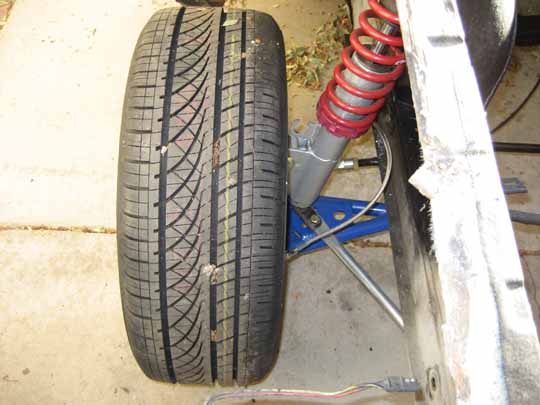 When it comes to
completely modifying
the front suspension of a Mustang and still having it be a bolt-on, the
best option is a coil over kit and many manufactures have this type of
product on the market. TCP, Ron Morris, Global West, and Fat
Man
all make some sort of coil over or strut front suspension for a
Mustang. Basically, these companies offer variations on the
same
theme. A coil over or modern strut type front suspension has
better leverage. This allows for more consistent tire to road
contact and allows for softer springs which, in turn, improves handling
and ride quality. That is one of the reasons why these kits
are
so expensive as they really do a lot to improve the way the car handles
and drives. A classic Mustang with one of these kits will
respond
in the front more like a new car. What really makes it more
like
a new car is you improve control of wheel movement over changes in the
road without increasing the stiffness of the front suspension, which in
turn maintains or improves ride quality over a stock suspension. The
location of a stock spring perch is approximately centered between the
pivot shaft of the control arm and the ball joint. The main result of
this is adequate but minimal leverage between the arm and
suspension. By relocating the lower coil-over mount
closer
to the spindle on the LCA, the length increase over the UCA mounting
location improves leverage. An added benefit is reduced road
vibration because vibrations are more effectively transferred directly
into the spring and shock, where it is absorbed. Coil over
kits
also provide complete adjustability in aligning the car (as mentioned
earlier) and most coil over shocks can be adjusted in both stiffness
and spring location, resulting in adjustable ride quality and ride
height. When it comes to
completely modifying
the front suspension of a Mustang and still having it be a bolt-on, the
best option is a coil over kit and many manufactures have this type of
product on the market. TCP, Ron Morris, Global West, and Fat
Man
all make some sort of coil over or strut front suspension for a
Mustang. Basically, these companies offer variations on the
same
theme. A coil over or modern strut type front suspension has
better leverage. This allows for more consistent tire to road
contact and allows for softer springs which, in turn, improves handling
and ride quality. That is one of the reasons why these kits
are
so expensive as they really do a lot to improve the way the car handles
and drives. A classic Mustang with one of these kits will
respond
in the front more like a new car. What really makes it more
like
a new car is you improve control of wheel movement over changes in the
road without increasing the stiffness of the front suspension, which in
turn maintains or improves ride quality over a stock suspension. The
location of a stock spring perch is approximately centered between the
pivot shaft of the control arm and the ball joint. The main result of
this is adequate but minimal leverage between the arm and
suspension. By relocating the lower coil-over mount
closer
to the spindle on the LCA, the length increase over the UCA mounting
location improves leverage. An added benefit is reduced road
vibration because vibrations are more effectively transferred directly
into the spring and shock, where it is absorbed. Coil over
kits
also provide complete adjustability in aligning the car (as mentioned
earlier) and most coil over shocks can be adjusted in both stiffness
and spring location, resulting in adjustable ride quality and ride
height.
Mustang II One suspension option that has been very popular with hot rod builders for years and has found its way into many classic Mustangs is retrofitting a Mustang II front suspension to your application. Changing to a Mustang II front suspension is by no means a bolt-on upgrade and involves welding in a new cross-member, as well as new mounting pieces for control arms and other suspension pieces. One major advantage to a Mustang II suspension is it allows you to remove the shock towers so that there is more room in the engine compartment for a big block, and, in my humble opinion, that is the ONLY reason to do a Mustang II swap unless there are other issues like damaged shock towers. Too much suspension geometry changes when going from stock suspension to a Mustang II set up. To begin with, one of the main aspects of steering geometry, Ackerman angle, is incorrect. Also, suspension travel is reduced, which hurts ride quality. A Mustang II setup is still better than a completely stock original setup but not as good as a modified stock front end like the one I described under “street profile”.
IRS Independent Rear Suspension  As with any
technical information, it is
always best to get our terminology correct. There are two families of
rear ends, IRS units and solid housing units, correctly referred to as
live axles. An IRS unit is as it states, suspension that is independent
between the drivers side and passengers side. The other option, the
“live axle”, is a solid unit that ties both the
driver’s and
passenger’s side suspension together. With a live axle,
suspension
movement on one side of the car affects the suspension on the other
side of the car. This can make tire to road contact a problem,
especially on rough roads or during tight high speed cornering. With
IRS, as one side of the suspension is moving due to bumps, road
imperfections and/or cornering, the tire on the other side can remain
unaffected and in proper contact with the road. Overall, IRS vastly
improves rubber to road contact, which will not only allow for better
handling but as a whole, a smoother more consistent ride. Better
handling and a smoother ride is why most front suspensions are of an
independent design. Even though IRS units are far superior to live
axles, in most situations most manufactures of rear wheel drive cars
uses live axle units for the sake of simplicity and, as a direct result
of simplicity, reduced costs. Upgrading from a live axle to
IRS
is a major project I had done extensive research involving Corvette
IRS, late model Cobra Mustang IRS, late model T-bird IRS and many of
the aftermarket IRS options, all of which were big dollars and
problematic, especially with the narrower 58” wheel base of
the 65-66
Mustangs. I figured that an IRS suspension upgrade was beyond my means
but it still was a persistent thought in my mind, kind of like an itch
that wouldn’t go away. In a feeble attempt to
“scratch the itch”, I
searched eBay from time to time with no real consistency, regularity or
expectation of actually finding something. In January of 2007, one such
search turned up a trick aftermarket IRS unit and I made a post about
it on a Mustang forum that I am a regular on. One of the responses told
me that basically what I was looking at was an aftermarket suspension
set up based on an original Jaguar IRS unit. This new information
fueled further research, which yielded many results including an
original IRS unit designed by Ford for the Mustang. More
information on installing IRS in a Mustang As with any
technical information, it is
always best to get our terminology correct. There are two families of
rear ends, IRS units and solid housing units, correctly referred to as
live axles. An IRS unit is as it states, suspension that is independent
between the drivers side and passengers side. The other option, the
“live axle”, is a solid unit that ties both the
driver’s and
passenger’s side suspension together. With a live axle,
suspension
movement on one side of the car affects the suspension on the other
side of the car. This can make tire to road contact a problem,
especially on rough roads or during tight high speed cornering. With
IRS, as one side of the suspension is moving due to bumps, road
imperfections and/or cornering, the tire on the other side can remain
unaffected and in proper contact with the road. Overall, IRS vastly
improves rubber to road contact, which will not only allow for better
handling but as a whole, a smoother more consistent ride. Better
handling and a smoother ride is why most front suspensions are of an
independent design. Even though IRS units are far superior to live
axles, in most situations most manufactures of rear wheel drive cars
uses live axle units for the sake of simplicity and, as a direct result
of simplicity, reduced costs. Upgrading from a live axle to
IRS
is a major project I had done extensive research involving Corvette
IRS, late model Cobra Mustang IRS, late model T-bird IRS and many of
the aftermarket IRS options, all of which were big dollars and
problematic, especially with the narrower 58” wheel base of
the 65-66
Mustangs. I figured that an IRS suspension upgrade was beyond my means
but it still was a persistent thought in my mind, kind of like an itch
that wouldn’t go away. In a feeble attempt to
“scratch the itch”, I
searched eBay from time to time with no real consistency, regularity or
expectation of actually finding something. In January of 2007, one such
search turned up a trick aftermarket IRS unit and I made a post about
it on a Mustang forum that I am a regular on. One of the responses told
me that basically what I was looking at was an aftermarket suspension
set up based on an original Jaguar IRS unit. This new information
fueled further research, which yielded many results including an
original IRS unit designed by Ford for the Mustang. More
information on installing IRS in a MustangThe Mustang has the heart of a lion with the sleek sporty lines to rival any sports car, but it is built on the chassis of a 4-door family car, the Ford Falcon. In other words, when it comes to chassis performance, specifically in handling, the Mustang has LOTS of room for improvement. One attribute of the Mustang that it definitely gets from it roots in the Falcon is the unibody design. Basically, unibody means that the car does not have a solid frame running full length of the car from the front to rear. With the unibody in mind, anything you can do to reduce flex in the body will typically improve handling by allowing the suspension part to be consistently positioned, resulting in less changes in the suspension, due to road imperfections, can be transferred into the chassis via body flex. Monte Carlo bar  Monty
Carlo bar is
the first line of
defense in stiffening the chassis. A Monty Carlo bar is
simply a
steel bar with mounting brackets on each end that fits between the
inner fenders just in front of the shock towers. This allows
both
towers to work together rather then independently as suspension changes
apply forces to the front clip. It also works with the
factory
firewall supports or export brace to triangulate the front clip. Monty
Carlo bar is
the first line of
defense in stiffening the chassis. A Monty Carlo bar is
simply a
steel bar with mounting brackets on each end that fits between the
inner fenders just in front of the shock towers. This allows
both
towers to work together rather then independently as suspension changes
apply forces to the front clip. It also works with the
factory
firewall supports or export brace to triangulate the front clip.Export brace 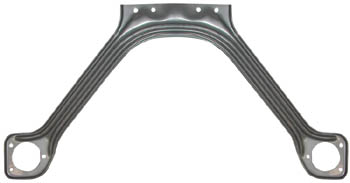 Ford knew
that the
shock towers would
see the most changes in pressure and that quite a bit of force would be
applied to them. To help deal with these forces, Ford built
removable steel supports that tied the top of the shock tower to the
center of the fire wall, helping to transfer the suspension forces
applied to the shock tower directly into the main body of the
car. While somewhat effective, being small and removable,
they
are not the best design. Ford realized this and designed a
solid
one piece unit that could more effectively tie the shock towers and
fire wall together and installed them on cars that would be sent over
seas due to the more aggressive driving of these cars in
Europe’s roads
such as the auto bon. That is why this piece is called an
Export
brace. Ford knew
that the
shock towers would
see the most changes in pressure and that quite a bit of force would be
applied to them. To help deal with these forces, Ford built
removable steel supports that tied the top of the shock tower to the
center of the fire wall, helping to transfer the suspension forces
applied to the shock tower directly into the main body of the
car. While somewhat effective, being small and removable,
they
are not the best design. Ford realized this and designed a
solid
one piece unit that could more effectively tie the shock towers and
fire wall together and installed them on cars that would be sent over
seas due to the more aggressive driving of these cars in
Europe’s roads
such as the auto bon. That is why this piece is called an
Export
brace. Sub frame connectors 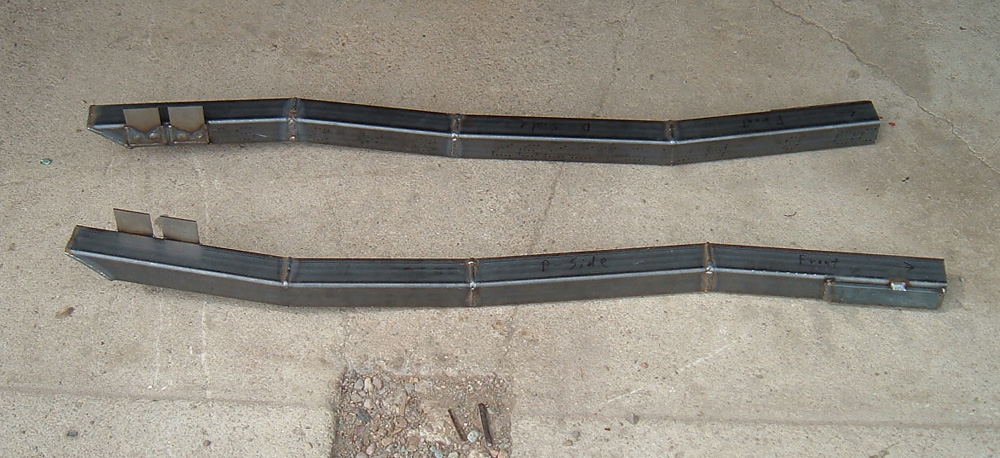 The
lack of a
frame is accomplished by
short frame rails at the front to attach the motor to and frame rails
at the rear to attach the rear end to. Connecting these two
sets
of frame stubs is nothing more than the body of the car, more
specifically the cab. Ford and many other manufacturers used this
design concept because it was cheaper to build and lighter.
The
problem with this design is that the body must hold its own weight and
react to ever changing road conditions. Off of the factory
floor,
the unibody design of the Mustang worked well, but over the last forty
years, daily abuse coupled with rust in key locations, can cause a car
to sag in the middle. Even if the car does not sag, if you
look
at any unrestored early Mustang, you will find a crack at the rear base
just below the rear side windows on one or both sides. This
is
the result of flex in the unibody. One simple fix to improve the
overall structural integrity of a Mustang, and a must for any Mustang
that is going to be used in performance applications, is to install
sub-frame connectors that join the front and rear frame rails, making
the frame a solid unit that runs the full length of the car. For
information on building your own sub-frame connectors, check out my sub-frame
connector page. The
lack of a
frame is accomplished by
short frame rails at the front to attach the motor to and frame rails
at the rear to attach the rear end to. Connecting these two
sets
of frame stubs is nothing more than the body of the car, more
specifically the cab. Ford and many other manufacturers used this
design concept because it was cheaper to build and lighter.
The
problem with this design is that the body must hold its own weight and
react to ever changing road conditions. Off of the factory
floor,
the unibody design of the Mustang worked well, but over the last forty
years, daily abuse coupled with rust in key locations, can cause a car
to sag in the middle. Even if the car does not sag, if you
look
at any unrestored early Mustang, you will find a crack at the rear base
just below the rear side windows on one or both sides. This
is
the result of flex in the unibody. One simple fix to improve the
overall structural integrity of a Mustang, and a must for any Mustang
that is going to be used in performance applications, is to install
sub-frame connectors that join the front and rear frame rails, making
the frame a solid unit that runs the full length of the car. For
information on building your own sub-frame connectors, check out my sub-frame
connector page.Ride height is something that depends on lots of factors including, but not limited to, tire and wheel size, coil spring height and rate, rear spring rate, spring eye location, shock type, and ride height modifiers like shackle length, lowering blocks and thicker coil spring insulators. For most people, ride height is all about the look. Opinions vary but for most, the general look is one where the tires tuck up inside the wheel wells, the front sits slightly lower than the rear and the overall car sits fairly low to the ground. How far the wheels tuck, how much difference between the front and rear, and just how low the car sits in relation to the road is where the differences of opinion are and most Mustangs have a specific ride height tailored to that owner’s tastes. Front ride height Getting a good ride height is not just about getting the correct look it is also about getting the correct LCA positioning. For best handling the pivot for the LCA and the base of the spindle should be the same distance to the ground for "proper ride height". The shorter the springs or the more weight in the front end, the more the inner pivot will be lower then the outer pivot. If you do not like the front ride height of your car, cutting a partial or full coil off of the spring will lower the car, but be forewarned that it will also stiffen the springs. Also, keep in mind that it can take as much as one month for a Mustang to properly settle after the springs have been installed so be patient, especially if you do not like the ride height of the car after the install. Other than spring height and rate, wheel and tire size are the other easiest ways to adjust your front ride height. Rear ride height Rear ride height is affected by many of the same things as the front. The spring rate, arc, eye location and shackle length will have vast effects on ride height. Unlike with coil springs, there is not an option to “cut off a coil”, with a stock rear end you need to use lowering blocks to lower the back half of the car. The best option for getting the correct ride height in the rear is to chose the correct spring. Most of the ways of adjusting an existing ride height have adverse effects on handling. Extended shackles or air shocks to rase the rear endand or lowering blocks of greater than 1” to drop the rear end will both have a negative effect on the handling of the car. Technically steering is a separate issue from handling, however the steering and suspension parts need to work together and upgrading one will have definite effects on the other. There are several steering improvements to consider when rebuilding your front suspension. Roller idler 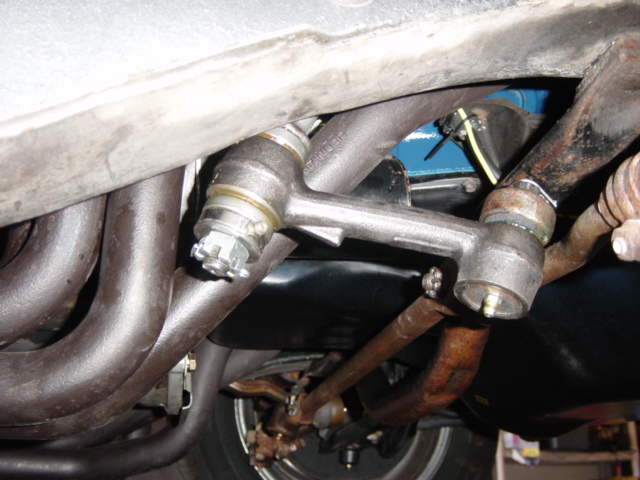 A roller
idler arm
uses the same basic
concept as a roller spring perch. By replacing a factory part
that uses rubber flex to achieve movement with a bearing that has a
smooth turning radius, you improving the moving characteristics of the
part. The roller idler arm does just that, it replaces the
rubber
with a bearing. This will take the flex created by the rubber
out
and give you crisp smooth steering. One concern with a roller
idler is that the rubber is there to help return the wheels to center
after turning. While this is true, it can easily be overcome
by
adding more caster, which will also center the tires after turning. A roller
idler arm
uses the same basic
concept as a roller spring perch. By replacing a factory part
that uses rubber flex to achieve movement with a bearing that has a
smooth turning radius, you improving the moving characteristics of the
part. The roller idler arm does just that, it replaces the
rubber
with a bearing. This will take the flex created by the rubber
out
and give you crisp smooth steering. One concern with a roller
idler is that the rubber is there to help return the wheels to center
after turning. While this is true, it can easily be overcome
by
adding more caster, which will also center the tires after turning.Rack and pinion Rack and pinion is a modern solution to a 40-year old problem. To put it simply rack and pinion steering allows you to replace the OEM steering box and outdated steering linkage with a more efficient, crisp, and precise all-in-one steering unit. The problem with many R&P units is that rather than being designed specifically for your Mustang, they are units designed for modern cars that have been made to fit in a classic. Just because it fits and turns doesn’t mean that it really works. When buying an R&P unit, do your homework and find one that has been built from the ground up for your car or one with the correctly modified geometry so that bump-steer and other steering issues will not be present.
Ackerman angle Another aspect of steering geometry is Ackerman angle, which is the angle that the steering arm has in relation to the rest of the car and controls the arch of the spindles when turning. If you think about it, when cornering, the inside wheel of the turn needs to turn sharper than the outside wheel. To accomplish this the difference between the inside and outside arc is determined by the angle of the steering arm, which in turn is calculated based on both the track width and the wheel base. Proper arm angle is created by angling the steering arms along a line drawn between both the LCA ball joint bisecting the steering arm pivot points and ending with the center line of the rear axle. The length of the arm creates the steering ratio where longer arms take less effort to turn the wheels but do not turn the wheels as sharply. In contrast shorter arms have a sharper turning ratio but require more effort to turn the wheel. Ackerman angle is the main reason why you can’t just take a spindle from one car and throw it on another unless there is a similar wheelbase and track width. Incorrect Ackerman angle and steering arm length will result in tire scrubbing during cornering, less front traction during cornering and reduced or over exaggerated turning radius.  Oversteer/Understeer
Without getting too technical and going into too much detail, oversteer and understeer are key factors in steering and, even though they are generally addressed by the factory design of the car, it is good to have a basic understanding of them so that if any changes you make to the suspension affect them you can see why. Oversteer is defined as the situation when the rear wheels do not follow directly behind the front wheels when turning and slide out toward the outside of the turn. The danger of oversteer is that it can throw the car into a spin. The susceptibility of a car to oversteer is affected by several things, such as traction between the tires and the road, aerodynamics, suspension and/or driver control. Oversteer is easier to induce in rear wheel drive cars by applying power in a tight corner. This happens because the rear tires must handle both the lateral cornering force and engine torque and by breaking the tire loose with torque, you will automatically loose traction latterly. Oversteer relates more to the back tires than the front, however, improving front traction can exaggerate existing oversteer. Understeer is a situation where due to slight traction loss in the front wheels, the car does not corner to a degree of sharpness that the angle of the tires would suggest. The effect is opposite to that of oversteer. In most cases, understeer is the result of loosing front traction to some degree from barely to completely. Since traction is the main factor relating to understeer, settings like camber that can significantly affect front tire traction have profound effects on understeer. With camber’s effect on understeer, most likely the reason Ford located the UCA where they did on the classic Falcon, Mustang, Cougar and all the other cars with similar suspension setups was to create a camber curve that lent itself to understeer. It is common practice among automobile manufacturers to configure production cars deliberately to have a slight understeer. If a car understeers slightly, it tends to be more stable (with drivers of less ability) if a violent change of direction occurs, thus improving safety. This does not mean that reducing understeer is unsafe, it just means if you are going to make the steering more responsive, you need to drive the car with that in mind. Vintage
legal track parts
When talking about suspension upgrades, some individuals want to maintain the over all stock configuration in appearance for the sake of originality or for racing where vintage type parts are required. A source for such parts is Opentracker Racing Products. Opentracker designs, modifies and fabricates high quality parts. He has two goals in mind and if you understand his goals, his products make a lot more sense. First, he wants to free up every aspect of the front suspension, in other words, roller everything. This is brilliant because the more freely the suspension can move, the better it can do its job. The second thing he does is maintains the stock appearance and overall utility of the original parts so that his parts are vintage legal/original. That is why all his products are still based on the original Ford design instead of starting from scratch. A perfect example would be his roller UCAs compared to a set of tubular UCAs. Vintage legal parts can be used on all kinds of cars from street driven to circle track and the best part is they are perfect for racing situations that require vintage legal parts.
Final
thoughts
As you can see, suspension is a very involved topic and there are many options and even more factors that come into play when designing the correct suspension system. I hope that this article has provided you with enough information to make an informed decision and has served to eliminate much of the confusion. If you take nothing else from this article, I hope you have learned one thing: “In order to correctly design a suspension package for your car, you need to first take a hard look at what you want to do with the car so that you can correctly build a suspension ideal for that application or a suspension that is the best compromise for varied applications.” I cannot stress enough the importance of making sure the way you design your suspension system is in line with the desired application of the car.
|



